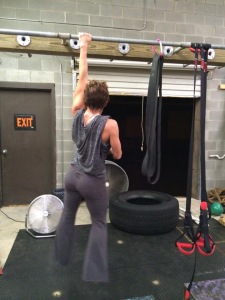Today's Training (April 16, 2015) and Just Hanging Around
Today’s Training – I am writing what my plan is for today’s training. Usually I write it as I am working out, but today I won’t be working out until later. So this is what I have planned:
Five Rounds
KB Deadlifts – double bells – 10 S-L-O-W and strict
Handstand Hold – facing the wall – 30 seconds
Hanging from the bar – 1 minute
Finish
Swings –
jump rope
rest
30/30/30
Five to ten rounds – need to see how it feels.
And now for “Just Hanging Around”
Hanging is a great exercise. Remember as a kid how you would play on the monkey bars and never get tired? Try that now. Ummmm, yeah. Not so easy anymore, huh? People do not realize how much it takes to be able to just hang on a bar. Seriously. Go try it. I have incorporated hanging work in my program. Mostly hanging knee raises and hanging leg raises. I plan to start with more passive hanging and work my way to one arm hangs. The following is from Ido Portal’s blog regarding hanging and what great benefits a person can derive from “just hanging around.” Full blog post can be seen at http://www.idoportal.com/blog/hanging
I am going to start with the passive hanging, which is described as follows: If I have no problems with the passive hangs, I will stick there, otherwise I will be retracting the scaps and starting with the active hang.
Passive Hanging – relaxed, deactivated, targets more of the passive structural integrity components than the more ‘muscular heavy’ hangs. It is where more often than not we will start with a beginner. (certain issues with shoulder health and integrity might require we start with active hangs for example).
I then plan to move on to Active hanging and finally Dynamic Hanging
2. Active Hanging – selective activation of the pattern, engaging musculature and minimizing the demands on passive structural integrity while maximizing the active-component demand and adaptation. Active hangs are a type of strength work. More specifically – Straight Arm Scapular Strength.
3. Dynamic Hanging – the use of a combination of passive/active hangs AND momentum to initiate a variety of dynamic actions such as Brachiation, Swinging, dynamic release and catch (Lache for example) and more.
The many benefits of hanging work.
Benefits of Hanging work:
1. Shoulder/elbow/wrist health and the recovery of the lost ‘overhead reach’ range – promoting optimal range and making use of the upper body as it was designed to be used. By simply allowing gravity to ‘do its thing’ in the passive work or “fighting it” in the active work – one can send a very intense adaptation producing signal into one’s structure.
2. Lead up to pulling work, climbing and more advanced patterns. Hanging sits at the base of those patterns, just like standing does for walking. A deficiency in hanging work will become evident at a certain stage – some get stuck early unable to develop even a single chin up. (very common female problem)
3. Active hang work is especially important tool in certain advanced phases and scenarios – as a plateau breaker for advanced pullers approaching the One Arm Chin Up for example.
4. Grip Strength and Grip Endurance. If you cant grip it – you cant manipulate it/yourself. We have grown weaker all over due to the lack in physical demands in our daily lives. Grip is no different.
PLEASE CLICK THE LINK AND READ IDO’S WHOLE BLOG POST FOR PRECAUTIONS AND SAFETY PRACTICES REGARDING HANGING. http://www.idoportal.com/blog/hanging
THIS IS MY GOAL:
This is a picture of Amy Lynn Cheek posted on Beth Andrews’ Facebook Page. Beth is a great coach and a Senior RKC Kettlebell Instructor from Georgia. In my opinion, Amy is the epitome of strength and beauty. This picture speaks volumes. Unreal!!
